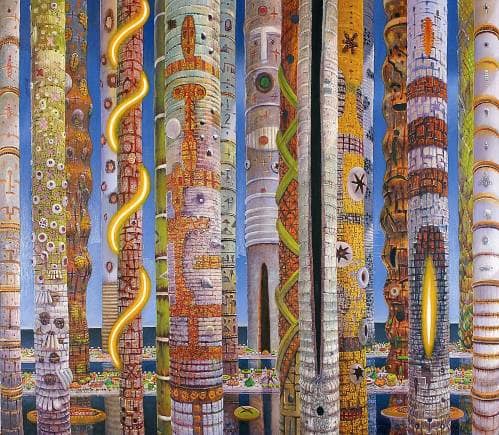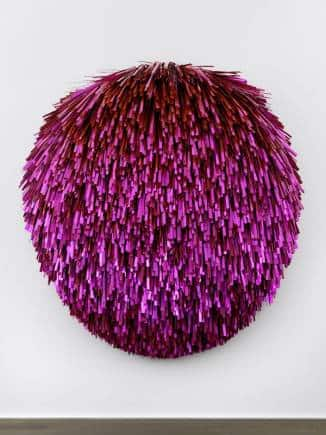



Note to readers: Desire for Dummies is a new series that will guide readers who are looking to be lavish on luxury or big-ticket investments by answering all the key questions they may have.
Professor Semir Zeki, a neurobiologist at the University College, London, in a research on the reasons why art continues to hold such an exalted position as a cultural marking among people, found that viewing of art increases dopamine and the activity in brain’s frontal cortex which results in experiencing pleasure similar to the kind derived from being in love or, the thing that is occupying much of are headlines today—recreational drug-taking.
The drug and dopamine bits aside, art can act as an investment, intangible and tangible: the former because it is a marker of a culture’s history and heritage, and the latter because it grows in value. Here is everything you wanted to ask about buying art and did not know where to look.
Why should I buy art?Answer: There could be multiple reasons for buying art. The most obvious should be for the love of art. A Barclay Bank’s survey a couple of years ago revealed that “the art market is highly psychological and social”. In a report entitled “Profit or Pleasure? Exploring the Motivations Behind Treasure Trends”, only a tenth of those questioned said they bought art purely as an investment; 75% cited enjoyment as the key. The study was based on interviews with 2,000 rich people in 17 countries.
Some of the richest art collections in India are today with organisations such as the Tata Group of Companies, Air India, and with business families, for most of whom it is an indulgence of their passion or a way to collect and preserve a part of India’s cultural history.
 But, not to forget, buying art engenders a feeling of “we have arrived”. Look at some of the most successful people around and you realize many of them are art collectors and aficionados, or at least have some art in their homes: Kumarmanglam Birla, Harsh Goenka, the Nadars, the Reddy family from Hyderabad, Ratan Tata, Kiran Mazumdar-Shaw and John Shaw. No, you don’t have to possess the deep collection, or deep pockets, that they do, but you can start somewhere. The analogy most commonly used by collectors is that buying art gives them a “high”.
But, not to forget, buying art engenders a feeling of “we have arrived”. Look at some of the most successful people around and you realize many of them are art collectors and aficionados, or at least have some art in their homes: Kumarmanglam Birla, Harsh Goenka, the Nadars, the Reddy family from Hyderabad, Ratan Tata, Kiran Mazumdar-Shaw and John Shaw. No, you don’t have to possess the deep collection, or deep pockets, that they do, but you can start somewhere. The analogy most commonly used by collectors is that buying art gives them a “high”.
Some collectors are interested in artworks for their aesthetical characteristics, and some see art as an investment, storage of wealth or a hedge against inflation. The others purchase art to be admitted to a certain social circle or to enhance their social status.
 Art by Shilpa Gupta Can art be an investment and pay me rich dividends?
Art by Shilpa Gupta Can art be an investment and pay me rich dividends? Answer: If you choose right and get expert advice, you could be sitting on a gold mine a few years later. Art does not correlate with the stock market. This means, if you invest right, paintings can go up in value even when the market crashes.
Just to give you an example: September 15th, 2008 was the day when Lehman Brothers filed for bankruptcy and set off a worldwide financial crisis and global recession. September 15th, 2008, was also the day when Sotheby’s London registered one of its most successful auctions of a work by British artist Damien Hirst.
The auction was expected to bring in at least $120 million over an evening and day sale, with a high estimate of $176.5 million. Sotheby’s ended up grossing $200.75 million over the course of two sales in 24 hours and becoming the most expensive single-artist auction ever. Seemingly, some of Hirst’s works were also bought by a collector in New Delhi. It offered a fillip to contemporary art market peaked, despite the critical situation the global financial system was in.
It was amid the coronavirus pandemic that Tyeb Mehta set a new world record for South Asian art at Christie’s post-lockdown art auction in New York with his ‘Falling Figure’ painting, which realised $975,000.
The point is to choose right, at the right time, and ensure that you build your portfolio sensibly. Always create a portfolio that is a blend of modern and contemporary Indian art. Among moderns you can count artists who gained prominence at the cusp of independence, the Bombay Group or the Progressive Indian Artists as they were known: M F Husain, FN Souza, SH Raza, VS Gaitonde, Tyeb Mehta, Akbar Padamsee, and such. The Progressives never fail in a resale or an auction. Artists such as Tyeb Mehta and Gaitonde have been drawing top billing at Christie’s, Sotheby and SaffronArt auctions and are rare to come by.
Then, diversify your portfolio, for the pleasure of holding a diversified collection; also, other artists, too, do well in both Indian and global markets and sometimes can be bought at far lesser amounts. Look at artists such as the late Bhupen Khakhar, Subodh Gupta, Bharti Kher, Atul and Anju Dodiya, Jitish and Reena Kallat, Bose Krishnamachari, Shilpa Gupta, and their several colleagues, who are in the collections of both aficionados and museums.
Their works not just add a contemporary flavour to your portfolio but are also great as investments as they never fail in the art and auction markets. Keep a lookout for promising young artists, who have the potential to grow. They are the ones who will give you big dividends in the years to come by, when their value rises and a work you had bought for a few thousand or a lakh or two, would get you three times or more of the price you spent.
 Art by Jitish KallatHow do I go about buying art?
Art by Jitish KallatHow do I go about buying art?Answer: There is no easy way: Educate yourself, acquire knowledge and understanding, read, surf and meet people when you can, and when things open, visit galleries, talk to gallerists, and travel to events such as Kochi Muziris Art Biennale and India Art Fair. If you are travelling internationally, drop in at Art Basel, considered the mecca for all art lovers and collectors.
Pierre Valentin, head of Arts and Cultural Assets team at London’s advisory firm, Constantine Canon, once said, "It would be rare for an individual to spend a million pounds on a property without turning to independent experts first, to verify the price and viability of the investment. Yet many people invest in art for the first time without first ensuring that its history, its seller and its value have been verified."
Art is about aesthetics, but it is as much about history, the value assigned to an artist and his work, and if you are an investor, how an artist’s work has performed over time.
Across 2020, as major art festivals stand cancelled or postponed, most mainstream and leading galleries haven’t hosted a show in weeks, even as artists retreat to their studios to produce more work. Gallery Espace, Gallery 88, Chemould Prescott Road, ICONART Gallery, Hyderabad, Emami Art, Kolkata, Vadehra Contemporary Art Gallery, Mahua, The Art Gallery, Bengaluru, GALLERYSKE, Bengaluru, The Apparao Galleries network and The Kiran Nadar Museum regularly hosts talks, online events and webinars through which you can familiarise yourself with what’s new in the art space and also pick up art history details.
 Jyothi Basu's Farewell PartyWhere can I buy art?
Jyothi Basu's Farewell PartyWhere can I buy art?Answer: Once you are ready to buy, our suggestion is to go straight to the gallery whose artists you have enjoyed and buy a painting or two. Good gallerists are also great advisors and can gauge both: Why you want to buy art and what are your price points. They can also help you build a portfolio with artists who they do not represent.
A pro tip: Sometimes, gallerists and curators at higher-end galleries may sound snooty, particularly if you are new. Leading dealers also, seemingly, like to place their holdings with established collectors to protect the works’ pedigree, so even if you can afford a major painting, a gallery may not want to sell it to you. Move on to more welcoming galleries and there are several. The art world in India is small and soon, word-of-mouth of your seriousness as a collector or investor is likely to get around even amongst the snootiest of galleries.
Another good space to buy art is the India Art Fair, held every January. From what we hear, there will be an edition, albeit a smaller one, in 2021 and you can browse through works of artists represented by a whole range of art galleries from India and abroad (New York, Paris, Berlin and London galleries often are represented at the fair). The India Art Fair is not as snooty as a high-end gallery, and once word gets around that you have bought a significant piece of art, even the supercilious will begin approaching you themselves.
A pro tip if you are an absolute newbie: On an online site or a gallery wall or its price list, if an artwork has a red dot next to it, it means it has been sold.
Once you are confident and armed with enough information, one of your best bets to buy a work of art are auctioned by global auction houses such as Christie’s and Sotheby’s, and Indian auction houses SaffronArt and AstaGuru, where you can purchase rare works of art.
 Art by Subodh GuptaHow do I determine a budget?
Art by Subodh GuptaHow do I determine a budget?Answer: There is no end to how much you can spend. So, set aside a budget and buy the best you can get in that category. You can always scale up or stretch yourself once in a while when a rare piece catches your fancy. As you see more art, meet more people, attend more webinars and understand art, you will be able to gauge why something is priced the way it is, and make sure that you're investing in the right work.
Also, arm yourself with a Plan B. If the work of an artist you admire is too expensive, consider smaller works by the same artist, a work on paper rather than an oil painting, an oil-pastel study, an older work or a photograph. Ask the gallerist if she or he has some works tucked away in the back room that may be cheaper. Never worry about sounding gauche. Everyone is out there to make a sale and you are their potential customer.
 Art by Tyeb MehtaWhat is the next step after buying an art?
Art by Tyeb MehtaWhat is the next step after buying an art?Answer: Art needs to be displayed in the right way. Any interior designer will help you create accent walls with your choice works of art, which are lit properly. A good thing to do would be is to create one or two well-lit gallery walls, depending on what the space permits, where you can keep changing the art pieces. A good interior designer will be able to help with the paraphernalia of a good gallery wall.
If you are storing some of your art, create a dry space, away from sunlight and pack your art up in a storage blanket or a bubble wrap. Ensure that the painting does not face the side you are taping up. If it is an unframed piece of art, cover the front of the canvas and then wrap using glassine paper, easily available with art galleries or even an art shop.
But the best way to treat your art is to sit back, enjoy your gallery and watch it give you not just years of pleasure but also become a crucial part of your investment portfolio.
Deepali Nandwani is a journalist who keeps a close watch on the world of luxury.Follow the entire Desire for Dummies series here.
Discover the latest Business News, Sensex, and Nifty updates. Obtain Personal Finance insights, tax queries, and expert opinions on Moneycontrol or download the Moneycontrol App to stay updated!
Find the best of Al News in one place, specially curated for you every weekend.
Stay on top of the latest tech trends and biggest startup news.